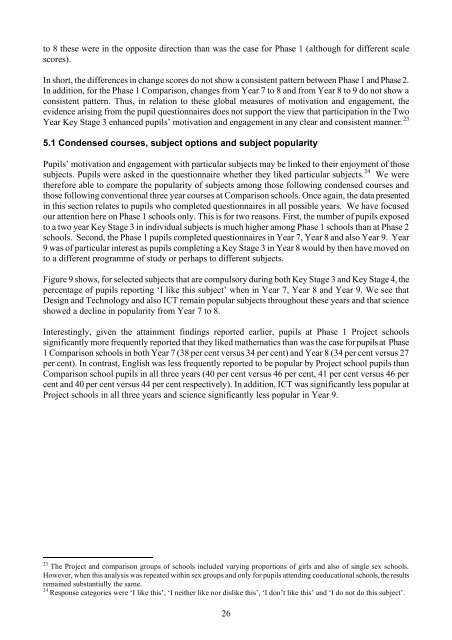Evaluation of the Two Year Key Stage 3 Project - Communities and ...
Evaluation of the Two Year Key Stage 3 Project - Communities and ...
Evaluation of the Two Year Key Stage 3 Project - Communities and ...
Create successful ePaper yourself
Turn your PDF publications into a flip-book with our unique Google optimized e-Paper software.
to 8 <strong>the</strong>se were in <strong>the</strong> opposite direction than was <strong>the</strong> case for Phase 1 (although for different scalescores).In short, <strong>the</strong> differences in change scores do not show a consistent pattern between Phase 1 <strong>and</strong> Phase 2.In addition, for <strong>the</strong> Phase 1 Comparison, changes from <strong>Year</strong> 7 to 8 <strong>and</strong> from <strong>Year</strong> 8 to 9 do not show aconsistent pattern. Thus, in relation to <strong>the</strong>se global measures <strong>of</strong> motivation <strong>and</strong> engagement, <strong>the</strong>evidence arising from <strong>the</strong> pupil questionnaires does not support <strong>the</strong> view that participation in <strong>the</strong> <strong>Two</strong><strong>Year</strong> <strong>Key</strong> <strong>Stage</strong> 3 enhanced pupils’ motivation <strong>and</strong> engagement in any clear <strong>and</strong> consistent manner. 235.1 Condensed courses, subject options <strong>and</strong> subject popularityPupils’ motivation <strong>and</strong> engagement with particular subjects may be linked to <strong>the</strong>ir enjoyment <strong>of</strong> thosesubjects. Pupils were asked in <strong>the</strong> questionnaire whe<strong>the</strong>r <strong>the</strong>y liked particular subjects. 24 We were<strong>the</strong>refore able to compare <strong>the</strong> popularity <strong>of</strong> subjects among those following condensed courses <strong>and</strong>those following conventional three year courses at Comparison schools. Once again, <strong>the</strong> data presentedin this section relates to pupils who completed questionnaires in all possible years. We have focusedour attention here on Phase 1 schools only. This is for two reasons. First, <strong>the</strong> number <strong>of</strong> pupils exposedto a two year <strong>Key</strong> <strong>Stage</strong> 3 in individual subjects is much higher among Phase 1 schools than at Phase 2schools. Second, <strong>the</strong> Phase 1 pupils completed questionnaires in <strong>Year</strong> 7, <strong>Year</strong> 8 <strong>and</strong> also <strong>Year</strong> 9. <strong>Year</strong>9 was <strong>of</strong> particular interest as pupils completing a <strong>Key</strong> <strong>Stage</strong> 3 in <strong>Year</strong> 8 would by <strong>the</strong>n have moved onto a different programme <strong>of</strong> study or perhaps to different subjects.Figure 9 shows, for selected subjects that are compulsory during both <strong>Key</strong> <strong>Stage</strong> 3 <strong>and</strong> <strong>Key</strong> <strong>Stage</strong> 4, <strong>the</strong>percentage <strong>of</strong> pupils reporting ‘I like this subject’ when in <strong>Year</strong> 7, <strong>Year</strong> 8 <strong>and</strong> <strong>Year</strong> 9. We see thatDesign <strong>and</strong> Technology <strong>and</strong> also ICT remain popular subjects throughout <strong>the</strong>se years <strong>and</strong> that scienceshowed a decline in popularity from <strong>Year</strong> 7 to 8.Interestingly, given <strong>the</strong> attainment findings reported earlier, pupils at Phase 1 <strong>Project</strong> schoolssignificantly more frequently reported that <strong>the</strong>y liked ma<strong>the</strong>matics than was <strong>the</strong> case for pupils at Phase1 Comparison schools in both <strong>Year</strong> 7 (38 per cent versus 34 per cent) <strong>and</strong> <strong>Year</strong> 8 (34 per cent versus 27per cent). In contrast, English was less frequently reported to be popular by <strong>Project</strong> school pupils thanComparison school pupils in all three years (40 per cent versus 46 per cent, 41 per cent versus 46 percent <strong>and</strong> 40 per cent versus 44 per cent respectively). In addition, ICT was significantly less popular at<strong>Project</strong> schools in all three years <strong>and</strong> science significantly less popular in <strong>Year</strong> 9.23 The <strong>Project</strong> <strong>and</strong> comparison groups <strong>of</strong> schools included varying proportions <strong>of</strong> girls <strong>and</strong> also <strong>of</strong> single sex schools.However, when this analysis was repeated within sex groups <strong>and</strong> only for pupils attending coeducational schools, <strong>the</strong> resultsremained substantially <strong>the</strong> same.24 Response categories were ‘I like this’, ‘I nei<strong>the</strong>r like nor dislike this’, ‘I don’t like this’ <strong>and</strong> ‘I do not do this subject’.26

















